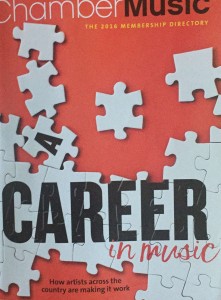[contextly_auto_sidebar]
Or, rather, who’s classical music’s competition? Especially when we go out in the world, who are we competing with? Which is something anyone in the field might do, whether you’re an entrepreneurial chamber ensemble, or a major opera company. You need to find a new audience. So when you look for one, who are you competing with?
 This is the subject of a piece I have in the new issue of Chamber Music magazine. To read it, follow the link, and go to page 66.
This is the subject of a piece I have in the new issue of Chamber Music magazine. To read it, follow the link, and go to page 66.
I’m asking an important question. When we work with the existing audience, we know them, and they know us. So they’re already on our side, even if they aren’t buying tickets this week.
When we reach to a new audience, this isn’t so. We’re talking — or trying to talk — to people who have no established interest in us. Which means they look at us as part of their wider world. What do we offer? How do we compare to what they already know?
New territory
And this is where things get tricky for us. We’re competing with everything our new audience cares about, and in fact with everything in their world. Including big national brands.
So we have to meet standards other than ours — and really, much higher than ours — in for instance advertising, in the language and design we use. Otherwise we don’t look plausible. I’ve seen big classical music organizations whose materials are blah, or worse. Some of them look like they’re community theater companies.
That won’t work. Our hoped-for new audience will look at what we’re showing them, and think we don’t measure up. That we can’t possibly be as engaging — and can’t be as artistic — as the things they already know.
This is hard for many people in classical music to believe. But I think that’s because too many of us don’t know enough about the wider world.
One last point
Which brings me to a final issue. Simple courtesy. If we’re going to reach out to people not part of our world, we have to respect them. We have to know what they’re about, what they like, what their culture is.
We can’t go out saying — loudly, gently, or by implication — that classical music is better than what these people already know. That’s a disaster as a marketing approach. “The music you like is crap! Listen to our stuff instead!”
But it’s also bad on a human level. It shows no interest in the people we’re trying to reach. And so it’s deeply discourteous.
My Chamber Music piece started as a talk I gave in June at the intense and wonderful Savvy Musician in Action entrepreneurship workshop. Margaret Lioi, the CEO of Chamber Music America, heard the talk, and asked me to make a written version for the magazine. Thanks, Margaret! I think my thoughts can be helpful, and it’s good to work with you.
On January 7, just before the Chamber Music America conference, I’ll be part of a Savvy Musician pre-conference day workshop on marketing chamber music. I’m looking forward to that. I’ll then be at the conference itself. Hope to see some of you there!

I see the primary competition is speakers and headphones.
Live acoustic music has greater emotional power, producing chills, goose bumps and tears of joy and sadness. The human connection of music starts with fingers and lips and fills a room, shared by performers and audience. Classical music can be dramatic crescendos or soothing relief from anxiety and insomnia, but is far more potent in person.
BUT, people will not come experience it because radio re-branded music as exciting, adrenalin pumping entertainment and distraction for short attention spans, or masking noise for the constant sonic interruptions of post-industrial life.
Speakers and headphones don’t impact with the sense of gravitas and vast space of a symphonic presentation or the intimacy and nuance of articulation in Chamber Music so recording producers substitute a level of neural abrasion to capture attention. Audio engineers are very clever about numbers, but you can’t capture a roomful of musical meaning on a disc whether grooved, pitted or covered in magnetic domains, nor the feeling of communing with other humans. The engineers hardly ever hear live acoustic music – they are trapped in studio rooms with speakers. The public never hears music without the intermediation of the knob tweakers and speakers, whether computer, ‘HiFi’ or PA.
If we can get people to sit still and listen longer than 3 minutes to human powered music, that is more than half the battle. With Broadway and Jazz clubs given over to the PA paradigm, Classical and some houses of worship are the last remaining bastions of human to human music, regardless of genre.